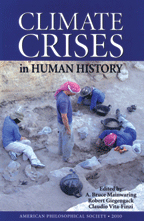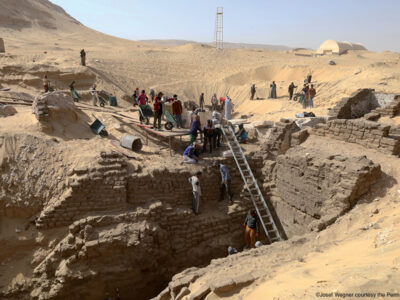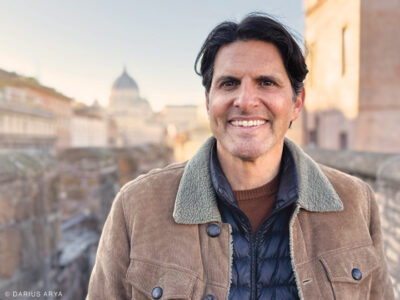Climate Change, Dark Ages, and Armchair Disaster Prediction

Yes, but.
That may be the best way to describe the position taken by A. Bruce Mainwaring C’47, Robert Giegengack, and Claudio Vita-Finzi on the subject of global warming: Measures to cut carbon dioxide emissions definitely make sense, but science still has a ways to go to when it comes to reliably predicting future climate impacts. Oh, and paying more attention to how human societies in the past responded to severe climate change couldn’t hurt, either.
In the introduction to Climate Crises in Human History, a recently published collection of papers presented at a 2008 conference that they coedited, the three put their purpose this way: “to highlight the uncertainties in both stimulus and response, and in so doing rein in those who think they know what is best for the rest of us.”
At a November symposium at the Penn Museum of Archaeology and Anthropology, Giegengack—emeritus professor of earth and environmental science at Penn and a famously engaging teacher—resorted to a more colorful means to make the point that climate change is not a recent phenomenon and that the Earth’s temperature has been fluctuating for a very, very long time.
Allowing that it was an “outrageous metaphor,” Giegengack took a roll of toilet paper out of his bag. He told the amused audience at Rainey Auditorium that, when measured proportionally, each inch of the 1,000-sheet roll is roughly equivalent to one million years of the Earth’s 4.5-billion-year history. Using those proportions, 1/100 of an inch of the entire roll represents all of recorded human history. And despite there being evidence of “both the lowest temperatures and the lowest concentrations of carbon dioxide in the atmosphere” happening within the last million years, he said, today’s scientists are mainly looking at the last 200 years when studying climate change. That’s a lot of unused toilet paper.
“Climatologists … are taking records of those 200 years,” Giegengack said, “subjecting it to very detailed analysis, and projecting it into computer models of what the climate will be like in the future based on this.”
He held up the tiny sliver of one sheet of toilet paper to represent this.
“Those of us who have some experience looking at the longer-term history of climate,” he continued, “would like to think that speculation might benefit quite substantially from learning all we can from the information included in the previous 999 sheets.”
Such was the theme of the entire discussion, which didn’t so much delve into the specific archaeological evidence detailed in Climate Crises, but instead emphasized the necessity, in more general terms, of looking much deeper into the Earth’s history to find patterns of climate change that may very well help with today’s environmental issues. (As it happens, Penn researchers have recently documented sea-level changes, which are linked to climate changes, going back 2,000 years [“Gazetteer,” Sept|Oct 2011].)
In addition to Giegengack, the other panelists were Graeme Barker, the Disney Professor and head of the Department of Archaeology at the University of Cambridge, and Joseph Farrell, professor of classical studies and the Joseph B. Glossberg Term Professor in the Humanities at Penn.
Barker, in the words of Museum director Richard Hodges, “took a romp around the globe” as he reviewed the record of climate changes during different civilizations throughout history, including the ancient Maya, the Saharan ancestors of the ancient Egyptians, ancient Romans, and medieval Europeans.
Farrell’s presentation focused on the treatment of climate change in Rhys Carpenter’s 1968 book Discontinuity in Greek Civilization, which he called “one of those books that actually changes your mind about something—and does so permanently.” Carpenter hypothesized that global warming was the cause of two “Dark Ages”: the famous one that followed the fall of the Roman Empire in the fifth century; and the period of Greek history between 1200 and 800 BC, for which, Farrell allowed, material evidence is comparatively scant.
But simply knowing that the Greek Dark Ages, as that period is called, existed got Farrell thinking that the “narrative of Western history that considered the later dark ages a kind of unfortunate and even anomalous interruption” was a lazy one. He suggested instead that recurring “dark ages” might even be the norm. He is convinced that global-warming trends led to the fall of the civilizations that preceded both of these dark ages.
“The most important events in history might not have anything to do with great men,” Farrell said, “and might have everything to do with occasional, however minor, fluctuations in climate.”
Farrell ended his presentation on a foreboding note—that the amount of time between Carpenter’s two dark ages is approximately the same amount of time from the end of antiquity to the present day. “In other words,” he said, “if Carpenter’s thesis were correct, and his dark ages were caused by periodic changes in the earth’s climate, then we should be just about ready for the latest installment of a long-running series of disaster movies.” Of course, he quickly added, it’s not quite that simple. We can only make educated guesses as to what the climate will do while taking measures to “at least not make the situation worse.”
What kind of measures can we take to help curb today’s evident global warming? Vita-Finzi, who was not a panelist but discussed some of the issues from the front row of the auditorium, said that two things we obviously should be doing, based on our past knowledge, is economizing on fuel and not polluting the atmosphere with carbon dioxide. “But,” he added, “pretending we know exactly what will happen in five or 10 years is insane.”
Vita-Finzi, who has written books on the sun and other earth-science topics and is affiliated with the Natural History Museum in London, also addressed the rarity of archaeologists studying climate change. Most of them, as he put it, seem to care more about “pots and jewels and swords and wars, and whether that scar was done by sword or axe” than climatic influence—which he admitted is more “indirect and often mysterious.” But books like Climate Crises in Human History are important, he said, even if they show that their authors don’t have all the answers when it comes to future climactic trends.
Giegengack has spoken out in the past about those who think they have all the answers based on so-called “recent” trends [“Gazetteer,” May|June 2007]. In a 2007 Philadelphia magazine story, the Penn professor blasted Al Gore for his global-warming documentary AnInconvenient Truth, which he said was filled with scientific inaccuracies and used “scare tactics” to get his point across.
For Giegengack, it’s difficult to see the global-warming issue being used as a political cudgel knowing that planetary temperatures have gone through regular cycles of rising and falling for the past 650,000 years.
“I think we can say, in the history of the Earth, there has never been a time when … people would not have been at risk to the consequences of climate changes, whether warming or cooling,” Giegengack said. “The problem today is the population pressure and the extraction of resources—because climate change has been with us continuously.”
—Dave Zeitlin




